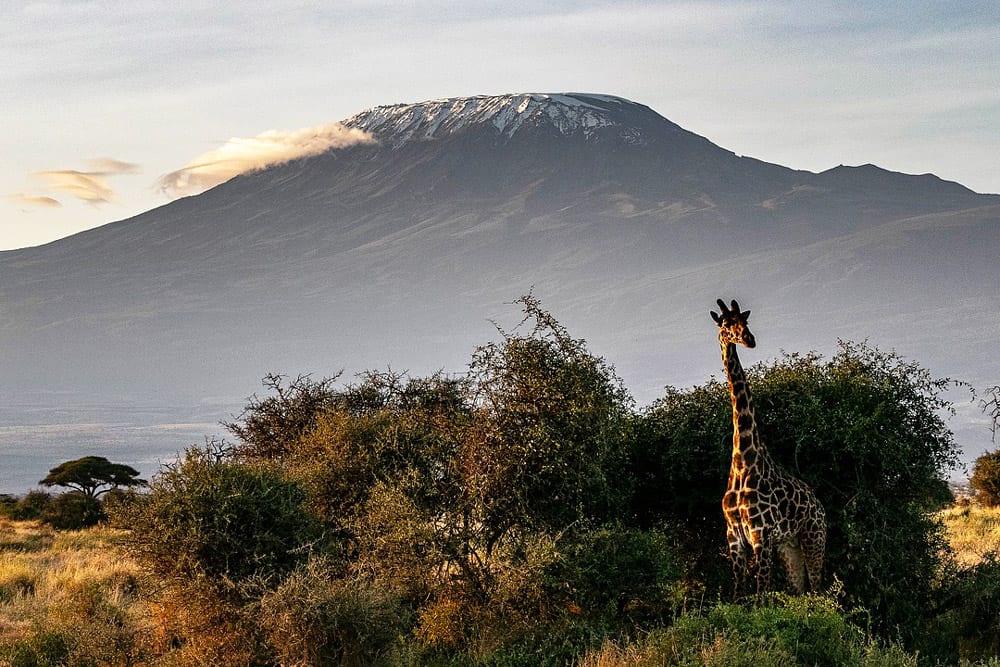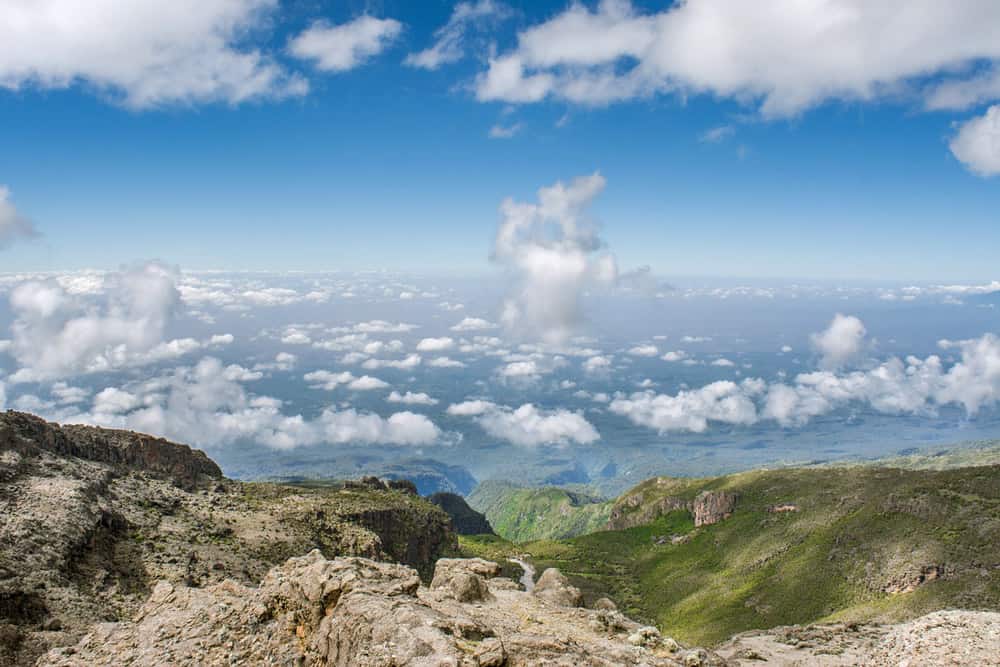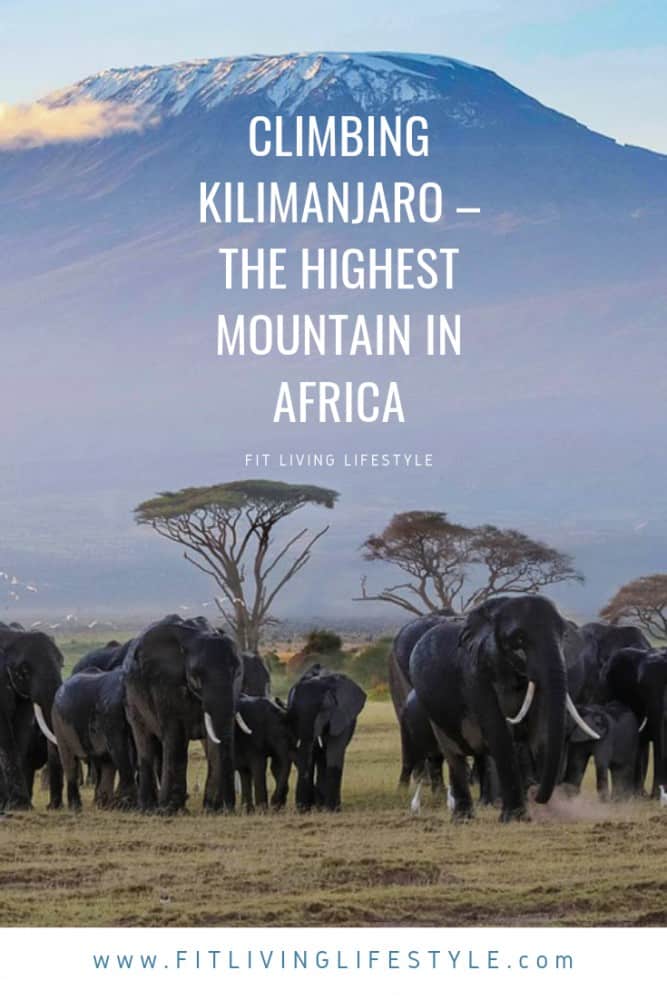Climbing Kilimanjaro is on many bucket-lists – the idea of ‘conquering’ one of the Seven Summits, and pushing yourself physically makes it a compelling destination.
That you can trek to the summit – it’s not a technical climb – means it’s accessible to anyone with a sense of adventure, and a good level of fitness.
Love hiking? Check out the Best Hikes Near Seattle
A Few Facts About Climbing Kilimanjaro
Standing 19,341ft above sea-level, Mount Kilimanjaro falls into the “extreme altitude” category – saying that, it’s not technical, so no climbing skills are required.
It takes anything from 5-10 days to get to the summit – via 7 different routes. Each route has its pros and cons, and you’ll need to decide in advance which you want to do
You have to use a registered tour operator for your climb. Solo or self-supported hiking and trekking are not permitted by the National Parks Authority.
Your kit will be carried by porters and your camp will be set up each day. You will carry a daypack with the things you need for the duration of the day’s hiking – the tour operator’s staff take care of the rest.
The Whys…
Everyone has their own personal reasons for wanting to tackle Mt. Kilimanjaro. For some of us, it’s a physical challenge, for others it’s a personal quest. For some it’s all about the summit, for others it’s about the scenery.
This trek can be a great opportunity to level up your fitness game and train a bit differently, with a clear end goal in mind.
The experience of hiking on Kilimanjaro’s slopes is unforgettable – a place of tropical forests, rock, and ice: a snow-capped peak on the Equator. Getting to know your guides and porters, hearing about their lives and families, seeing their enthusiasm for this mountain.
You do get back to basics a bit. The camps are mostly comfortable – although altitude can cause sleep issues. The days hiking can be tough – 7-9 hours a day – whilst not technical, it’s a slog.
But your worries and stresses of home are replaced by the simplicity of the climb. You focus on one thing: moving forward, one foot in front of the other, through spectacular landscapes.
The Hows…
Getting There: The nearest airport is Kilimanjaro International Airport. There are direct flights from Europe via KLM, or the Middle East with Qatar Airways. Numerous flights go from Dar-es-Salaam in Tanzania or Nairobi, Kenya.
Visas: You will require a visa to enter Tanzania. It’s best to arrange this in advance with your local embassy, but in some cases, it can be arranged at the airport, on arrival.
Vaccinations: At the time of writing, Tanzania requires a Yellow Fever certificate if you are traveling through a country that is at risk of the disease. Check with your doctor for any other recommended vaccinations well in advance.
Malaria: Whilst malaria is not an issue once you get over 10,000ft, your time in the towns at the bottom of the mountain can put you at risk. You will need a good bug spray and anti-malarial medication. Check with your doctor well in advance.
Water: Tap water in Tanzania is not safe to drink. On the mountain, your operator should be providing you with boiled, filtered water for the duration of your climb, and in town be sure to only drink tap water.
Things to know before going
General Health
This is an obvious one, but to trek to over 19,000ft, you’ll need to get a clean bill of health from your doctor. A reputable tour operator will always ask for a medical release form from your healthcare professional. It’s important to note that some pre-existing conditions and medications can interact poorly with altitude, causing issues that you may be unaware of.
Fitness
You will need to be fit and strong – that’s not to say that people in sub-optimal shape haven’t managed to get to the summit – they have. The less physically fit you are the more mental stamina you’ll need. The days can be long, and sleep can be elusive at the higher elevations.
You need a decent level of fitness and strength to make the hike enjoyable. You don’t want to arrive at camp each evening exhausted, and wake up sore and cranky the next morning. Signing up for a Kilimanjaro climb can be a great way to kickstart your fitness goals. And then exceed them!
As a starting point, check out our Adventure Workout Template: Preparing for your next Adventure.
However, fitness is not everything: there’s still the altitude to contend with, and no amount of training can prepare your body for that.
Choosing a Tour Operator
You can’t hike anywhere on Kilimanjaro’s slopes without a licensed tour operator. There are many to choose from – both locally in Tanzania and in US/Europe. Climbing Kilimanjaro is not cheap, and trying to save a few bucks with the cheapest tour operator is not a good idea.
The difference, in brief, between a good and a bad operator will be along these lines:
- Quality of the gear they use – you don’t want a leaky tent at 15,000ft!
- Quality of the food they provide
- The welfare of their staff: a porter’s life is a tough one, and you want an operator to be registered with Kilimanjaro Porter’s Assistance Project
- Guide training: it’s important that your guide is properly trained for your safety. Guides need to be trained in emergency procedures and be able to recognize symptoms of altitude sickness
- Safety gear and procedures: what are the processes in place if you need to be evacuated from the mountain?
Do plenty of research, ask around and get recommendations from the hiking groups/forums. You don’t want to take unnecessary risks with your life.
What to pack
From the base to the summit, Kilimanjaro can be compared to hiking from the Equator to the North Pole, in terms of climate zones. You’ll trek from the low-lying cultivated areas and forests of the lower slopes, right up to the Arctic tundra of the Ice Cap zone of the summit
Getting a Kilimanjaro gear list together beforehand is important. You’ll only be allowed 15kgs of weight in your duffel bag which is carried by porters, and whatever you can carry in your daypack.
A basic packing list would include:
- 4-5 Pairs of Underwear
- Top and Bottom Base Layer
- 3-4 Short Sleeve and 1-2 Long Sleeve Shirts
- 1-2 Pairs of Hiking pants
- 1 Fleece Jacket
- 1 Insulated Winter Jacket
- 1 Insulated Pants
- 1 Hard Shell Jacket
- Lightweight Raingear
- Sun Hat
- Warm Beanie or Fleece Headband
- Headlamp
- Sunglasses (for high altitude wraparound glacier glasses)
- Lightweight liner Gloves & Warm Outer Gloves / Mitts
- Adjustable Hiking Poles
- Mid-weight Hiking Boots
- Camp Trainers / Trekking Sandals
- 4-5 Pairs of Trekking Socks & 1 Pair of Thermal socks
- 80-90L Waterproof Duffle Bag & 20-30L Daypack
- 4-Season Sleeping Bag
- Insulated Sleeping Mat
- Water Bottles or 2-3 liter Hydration Bladder
- Water Purification Tablets
- Baby Wipes
- Sweat Resistant Suncream
- Blister Platers
- Insect Repellant
- General Medications (Paracetamol, Imodium)
- Passport, Visa, Insurance, Yellow Fever Card (if applicable)
Personal experience of the climb
There’s no technical element to Kilimanjaro – the days are long, tough, hiking. As you get higher up, the altitude makes it even harder. The train is rough and steep in some parts, as you climb higher there can be frost underfoot.
The pace is very slow. In the beginning, you might feel it’s too slow – but as you get past 10,000ft, you’ll be glad of the steady, even pace, conserving energy and helping acclimatization.
It’s cold. The first couple of days, through the forest you would be forgiven for thinking that this was going to be a long, hot hike – at night the temperature drops, and it’s not unusual for there to be frost on the outside of your tent.
As you trek higher, closer to the summit, the days can be freezing cold, the frosty mountain air chilling you.
Your day starts early, and getting out of your sleeping bag can be difficult on a cold mountain morning. After a good, hearty breakfast you’ll have a health check – your guide will ask you how you’re feeling (yes, do be honest!) and then possibly use a stethoscope to listen for lung sounds and check your oxygen saturation.
On the trail, every day is a bit different. The weather can change quickly, especially as you get higher up, so one minute you might be peeling off layers in the sun, and the next you might be pulling on a raincoat.
You’ll normally have lunch somewhere on the trail – depending on your operator, this could be a picnic or a full cooked lunch. Normally around tea-time, you’ll arrive at camp – your tent is ready and waiting and it’s important to change out of the day’s clothing. Particularly if you got at all wet.
Eat well at dinner, even if you’re not feeling it. Sometimes altitude can make you feel less hungry than normal – but your body needs all the fuel it can get. The guide will often give you a briefing of the next day’s highlights, and need-to-knows. Early nights are normal, as you’ll be conserving energy and recovering.
Have you climbed Kilimanjaro recently? Are you planning to? Let us know in the comments…
Check out another great story about Hiking the High Sierra Trail

Hi, I’m Clare, the founder of TheHikingAdventure.com. I started this website with the simple mission of helping people plan, pack for and get going on their hiking journey.








